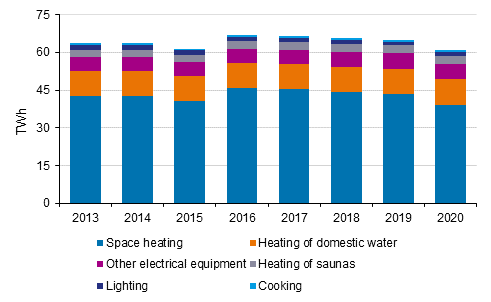Published: 16 December 2021
Decrease in heating consumption covered the effect of remote work on energy consumption in households in 2020
The year 2020 was record warm. Energy consumption in households fell by nearly four terawatt hours (TWh) from the previous year and the share of indoor space heating in energy consumption in households was exceptionally low, 64 per cent. The use of electricity for household appliances increased slightly. The energy consumed in households amounted to close on 61 TWh in 2020. The data are based on Statistics Finland's statistics on energy consumption in households.
Energy consumption in households in 2013 to 2020

Housing accounts, on average, for 20 per cent of the final energy consumption. Heating of indoor spaces consumes roughly two-thirds of the energy consumed in households. In 2020, the share of space heating was exceptionally low, 64 per cent. Good 39 TWh of energy was used to heat residential spaces. Heating consumption was ten per cent lower than the previous year's consumption. Energy consumption of free-time residences is also included in energy consumption in households.
In addition to the area to be heated and the energy efficiency of the building stock, the need for heating energy is also affected by the outdoor temperature. Its changes are monitored with heating degree days calculated for 16 localities. The year 2020 was the warmest year in the whole country during the reference period of the statistics.
In 2020, approximately 10 TWh, or 17 per cent of total household consumption, was used to heat domestic water. The share of electrical appliances, cooking and lighting was 14 per cent and rose by one percentage point from the year before. Remote work is estimated to have raised the electricity consumption of electrical appliances, such as computers and cookers. This is clearly visible in the consumption of cooking. The consumption of electrical appliances also includes car heating dependent on temperature. Its consumption dropped and cancelled out the increase in consumption caused by remote work. The remaining five per cent of energy consumption in households was used to heat saunas. Nearly two-thirds of the approximately three TWh used to heat saunas were wood and good one-third electricity.
Good one-third of energy consumption in households was electricity in 2020. Nearly one-third of consumption was district heat and good one-fifth wood. Around 22 TWh of electricity was consumed and consumption went down by only a couple of per cent from the previous year. Forty-five per cent of electricity was used to heat indoor areas and 39 per cent for household appliances. The remainder of electricity was used to heat domestic water and saunas.
Heating of residential buildings consumed 39 TWh of energy in 2020. The most common sources of energy for heating indoor spaces were district heat, wood and electricity, the share of which was 82 per cent of the energy consumption for heating indoor spaces. The next most common energy source was heat pump energy. The electricity use of heat pumps is included in electricity consumption of heating in the statistics on energy consumption in households.
The statistics on energy consumption in households are based on sales data collected from sellers of energy. Part of the data are received by sector and part by product. The breakdown required by the EU Regulation on energy statistics is produced with a calculation model. Several different data sources are exploited in the calculation model. Due to the production method of the statistics, growth in the consumption of electrical appliances cannot be directly verified from the data but is based on inferences made from observations. For example, according to the electricity statistics of the Finnish Energy Industries, the use of electricity in households in Helsinki grew by seven per cent from 2019 to 2020, while the number of household-dwelling units increased by close on two per cent. The dwellings of Helsinki, dominated by blocks of flats, are mainly heated with district heating, so the fall in electricity heating consumption does not cover the rise in electricity consumption caused by people working remotely from home.
Source: Energy consumption in households 2020, Statistics Finland
Inquiries: Virve Rouhiainen 029 551 3395, energia@stat.fi
Head of Department in charge: Katri Kaaja
Publication in pdf-format (269.6 kB)
- Tables
-
Tables in databases
Pick the data you need into tables, view the data as graphs, or download the data for your use.
Appendix tables
- Figures
Updated 16.12.2021
Official Statistics of Finland (OSF):
Energy consumption in households [e-publication].
ISSN=2323-329X. 2020. Helsinki: Statistics Finland [referred: 20.12.2025].
Access method: http://stat.fi/til/asen/2020/asen_2020_2021-12-16_tie_001_en.html

